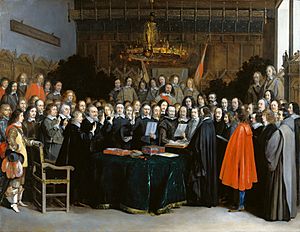Armistice facts for kids
An armistice is a formal agreement between groups who are fighting in a war. It means they agree to stop fighting. Think of it as a pause button in a conflict. An armistice is not always the end of a war. It might just be a stop to the fighting while they try to agree on a lasting peace. The word "armistice" comes from Latin words meaning "arms" (like weapons) and "a stopping."
The United Nations Security Council often tries to make groups stop fighting in modern conflicts. They do this with "ceasefire" resolutions. However, armistices are different. They are always agreed upon by the groups fighting the war themselves. This makes them feel more serious and binding than UN resolutions in today's international law.
An armistice is a temporary agreement. It is not the same as a peace treaty. A peace treaty is a final agreement that officially ends a war. It can take many months or even years to agree on a peace treaty. For example, the 1953 Korean War Armistice Agreement stopped the fighting in the Korean War, but a full peace treaty has never been signed. So, technically, the war is still not over. An armistice is also different from a truce or ceasefire. These are usually very short stops to fighting, often for a limited time or in a small area. Sometimes, a truce is needed to help groups talk about an armistice.
Contents
Armistices and International Law
Under international law, an armistice is a legal document. It officially ends the fighting between the groups involved in a war or conflict. At the Hague Convention of 1899, several agreements were made about how wars should be fought. One of these, the Convention with respect to the Laws and Customs of War on Land, talked about armistices.
It said that if an armistice does not have a set end date, the groups can start fighting again whenever they want. But they must tell the other side first. This is different from an armistice that has a fixed time limit. In that case, fighting can only start again after that specific time limit ends. If an armistice says it "completely ends the fighting" without any end date, it means the fighting should not start again at any time. The Korean Armistice Agreement is an example of this. It aimed for a "complete stop of fighting" until a "final peaceful settlement is achieved."
Armistice Day: A Special Date
Armistice Day is a special day we remember every year on November 11. It is also known as Remembrance Day or Veterans Day in some places. This day marks the signing of the Armistice of 11 November 1918. This agreement was signed between the Allies of World War I and German Empire in France. It stopped the fighting on the Western Front of World War I. The fighting officially stopped at 11:00 AM on the "eleventh hour of the eleventh day of the eleventh month" in 1918.
After World War II, most countries changed the name of this holiday. They wanted to honor veterans from that war and other conflicts too. Many countries in the Commonwealth of Nations now call it Remembrance Day. The United States calls it Veterans Day.
Old Armistices in History
- The Armistice of Copenhagen in 1537 ended a Danish war called the Count's Feud.
- The Armistice of Stuhmsdorf in 1635 was between Poland-Lithuania and Sweden.
- The Peace of Westphalia in 1648 ended two big wars: the Thirty Years' War and the Eighty Years' War.
See also
 In Spanish: Armisticio para niños
In Spanish: Armisticio para niños


